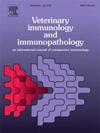Bovine papillomavirus gene expression and inflammatory pathway activation vary between equine sarcoid tumour subtypes
IF 1.4
3区 农林科学
Q4 IMMUNOLOGY
引用次数: 0
Abstract
Equine sarcoids are common non-metastasising skin tumours in horses, associated with bovine papillomavirus (BPV) infection. Six subtypes are recognised (occult, verrucose, nodular, fibroblastic, mixed and malevolent lesions), with variable clinical behaviour. The pathophysiology underlying varying tumour phenotype is poorly understood, and previous data on associations with viral load have been conflicting. To better understand this clinical variation, we investigated associations between tumour subtype and viral load, viral early protein gene expression, and expression of 10 host genes by quantitative polymerase chain reaction in 27 sarcoids and 5 normal skin samples. Viral DNA copy number did not differ between subtypes but was significantly higher in animals with fewer tumours. Expression of BPV E2 and E6 was higher in occult lesions compared to fibroblastic or nodular lesions, while E5 expression was higher in previously-treated lesions. Of the host genes, only IL6 and IL1B differed between subtypes, with higher expression in fibroblastic lesions, while IL10 and CCL5 were elevated compared to skin in all lesion types, and elevations in TNF and TGFB1 were significant for occult lesions only. Expression of TLR9, ATR , VEGFA and PTGS2 in sarcoids was not significantly different from normal skin, suggesting differences between BPV and human papillomavirus tumorigenesis. Results for BPV viral load and gene expression differed from previous reports and are insufficient to explain the spectrum of tumour phenotypes. Activation of both pro-inflammatory and anti-inflammatory immune pathways in sarcoids could influence tumour growth and effective immune responses, and the contribution of specific infiltrating immune cells requires further investigation.
牛乳头瘤病毒基因表达和炎症通路激活在马肉瘤亚型之间存在差异。
马肉瘤是马常见的非转移性皮肤肿瘤,与牛乳头状瘤病毒(BPV)感染有关。目前已确认有六种亚型(隐性、疣状、结节、成纤维、混合和恶性病变),临床表现各不相同。人们对不同肿瘤表型的病理生理学还知之甚少,以往关于病毒载量相关性的数据也相互矛盾。为了更好地了解这种临床变化,我们通过定量聚合酶链反应研究了 27 例肉瘤和 5 例正常皮肤样本中肿瘤亚型与病毒载量、病毒早期蛋白基因表达和 10 个宿主基因表达之间的关系。不同亚型的病毒 DNA 拷贝数没有差异,但肿瘤较少的动物的拷贝数明显较高。与成纤维或结节性病变相比,BPV E2 和 E6 在隐性病变中的表达量更高,而 E5 的表达量在曾接受过治疗的病变中更高。在宿主基因中,只有IL6和IL1B在不同亚型之间存在差异,在成纤维病变中表达较高,而在所有病变类型中,IL10和CCL5与皮肤相比都有所升高,TNF和TGFB1的升高仅在隐匿性病变中显著。肉瘤中TLR9、ATR、VEGFA和PTGS2的表达与正常皮肤无明显差异,这表明BPV与人类乳头瘤病毒的肿瘤发生存在差异。BPV 病毒载量和基因表达的结果与以前的报告不同,不足以解释肿瘤表型的范围。肉瘤中促炎和抗炎免疫途径的激活可能会影响肿瘤的生长和有效的免疫反应,而特定浸润免疫细胞的贡献还需要进一步研究。
本文章由计算机程序翻译,如有差异,请以英文原文为准。
求助全文
约1分钟内获得全文
求助全文
来源期刊
CiteScore
3.40
自引率
5.60%
发文量
79
审稿时长
70 days
期刊介绍:
The journal reports basic, comparative and clinical immunology as they pertain to the animal species designated here: livestock, poultry, and fish species that are major food animals and companion animals such as cats, dogs, horses and camels, and wildlife species that act as reservoirs for food, companion or human infectious diseases, or as models for human disease.
Rodent models of infectious diseases that are of importance in the animal species indicated above,when the disease requires a level of containment that is not readily available for larger animal experimentation (ABSL3), will be considered. Papers on rabbits, lizards, guinea pigs, badgers, armadillos, elephants, antelope, and buffalo will be reviewed if the research advances our fundamental understanding of immunology, or if they act as a reservoir of infectious disease for the primary animal species designated above, or for humans. Manuscripts employing other species will be reviewed if justified as fitting into the categories above.
The following topics are appropriate: biology of cells and mechanisms of the immune system, immunochemistry, immunodeficiencies, immunodiagnosis, immunogenetics, immunopathology, immunology of infectious disease and tumors, immunoprophylaxis including vaccine development and delivery, immunological aspects of pregnancy including passive immunity, autoimmuity, neuroimmunology, and transplanatation immunology. Manuscripts that describe new genes and development of tools such as monoclonal antibodies are also of interest when part of a larger biological study. Studies employing extracts or constituents (plant extracts, feed additives or microbiome) must be sufficiently defined to be reproduced in other laboratories and also provide evidence for possible mechanisms and not simply show an effect on the immune system.

 求助内容:
求助内容: 应助结果提醒方式:
应助结果提醒方式:


